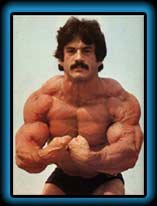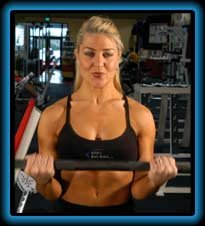As we all know, growth is triggered by training, and logic would suggest that more training equals more growth. Wrong. The secret to optimal results lies in finding the right balance between too little and too much, and once you've found that delicate balance, make sure that you make the most of it. Let's discuss how to identify and hit your window of maximum growth.
Training Too Much
 Spending 2 hours a day, 7 days a week in the gym may seem like the dedicated thing to do. Well, that's an A for effort and F for analysis. Every time you pump iron, you're tearing down muscle tissue. That tissue needs to be repaired, and you need both time and nutrients/energy for that process to take place. When you work out for hours on end, you're not adding any real stimulus to the muscle, just draining the batteries. Add insufficient rest between the workouts, and you have the recipe for burnout. A better -- and considerably more time-efficient approach -- is a modified Heavy Duty mindset.
Spending 2 hours a day, 7 days a week in the gym may seem like the dedicated thing to do. Well, that's an A for effort and F for analysis. Every time you pump iron, you're tearing down muscle tissue. That tissue needs to be repaired, and you need both time and nutrients/energy for that process to take place. When you work out for hours on end, you're not adding any real stimulus to the muscle, just draining the batteries. Add insufficient rest between the workouts, and you have the recipe for burnout. A better -- and considerably more time-efficient approach -- is a modified Heavy Duty mindset.
Bodybuilding legend Mike Mentzer once described muscles as a stick of dynamite; Tapping a hammer at it all day long won't do much, but a single, hard blow will set it off. Aim to hit your muscles with that blow. Once you've triggered the growth response, further training will just sap energy and prolong the catabolic state that follows strenous training. Now, Heavy Duty-training is extreme in its advocacy of heavy weights for a minimal number of sets and reps, but there's a large chunk of common sense to consider here.
I've found 2 sets per exercise, and 2-3 exercises per bodypart to be a happy middle ground; You get a couple of chances to give everything you've got, but not more than you need to trigger growth. Try to keep workouts in the 30-45 minute range (not counting the time in the locker room) and never more than 60 minutes, and get sufficient rest between workouts. The rule of thumb is to rest until the soreness is completely gone, possibly adding another day if you feel fatigued.
Training Too Little
You know that the growth occurs at home, between workouts, and want to make sure you don't miss out on any of the good stuff. That's good thinking, but taking it overboard can mean that you progress slower than necessary. The problem usually occurs because of bad pairing-up with other muscle groups.
Let's say you decide to train two specific muscle groups together. Group A takes 2 days to recover from the damage incurred by training, another day to overcompansate (aka. add a little bit more muscle in anticipation of the next workout) and perhaps one more day to get the energy levels up and ready. That's 3 to 4 days. So what's the point of waiting 6-7 days, when group B finally catches up?
A real-life example of this: Group A is calfs, while group B is quads. Calfs generally recover quickly (and may in many cases not even get sore at all!) while a good session of squats and leg presses will keep those knees feeling like rubber for several days. Obviously, the solution in this case is to train calfs twice a week (pairing them up with, say biceps/triceps 3 days later) while maintaining quads at once a week. You get the idea.
Making The Most Of The Training
 Ok, so you've got the training frequency down pat and arrive at the gym fresh and energized. The goal now is to hammer your muscles as hard as possible in as little time as possible, so that you can get back home and start the recovery process. But there's more to it than just loading on lots of plates. Weights in themselves are irrelevant, if the form is not right. We've all seen the guy loading on way too much and then sway all over the place as he tries to do bicep curls. The determining factor is how much of the weight is actually moved by the muscle you intend to train. As a bonus, your odds of getting a nasty injury drops dramatically.
Ok, so you've got the training frequency down pat and arrive at the gym fresh and energized. The goal now is to hammer your muscles as hard as possible in as little time as possible, so that you can get back home and start the recovery process. But there's more to it than just loading on lots of plates. Weights in themselves are irrelevant, if the form is not right. We've all seen the guy loading on way too much and then sway all over the place as he tries to do bicep curls. The determining factor is how much of the weight is actually moved by the muscle you intend to train. As a bonus, your odds of getting a nasty injury drops dramatically.
Consult with a personal trainer if you're not sure about your form. Another thing to consider is periodization. If you're always doing the same exercises using the same weights for the same number of reps, what prompts the body to change? You need to switch things around to avoid plateaus. Alternating exercises from one workout to the next is a good first step, but you also need to vary the weights and reps. This doesn't have to be very complicated; Doing 3 weeks of low rep, high weight training (4-8 reps) and 2 weeks of high rep, low weight training (10-15 reps) with a week of phasing in and out can be enough to keep the body guessing.
Last but not least, do not forget the importance of cardiovascular conditioning. Doing cardio is about as fun as listening to Al Gore doing stand-up comedy, but it's necessary to pull off the heavy compound movements such as deadlifts and squats. If your oxygenation process starts stumbling before your muscles do, you're robbing yourself of much of the benefit of the exercise.
Take note, however, that you need to crank up the speed of the treadmill to actually do aerobic training. Low-intensity cardio, i.e. the kind you see 90% of the people in the gym do, is great for burning fat but won't do much for your heart, lungs etc. Aim for 80-85% of your maximum heart rate (max = 208 - (0.7 x age in years) and keep at it for at least 15-20 minutes.
Of course, there are plenty of additional tricks you can employ to fine-tune your workouts, but this basic frame should get you started on the right foot. Good luck!
Thanks,
